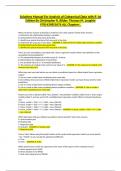Exam (elaborations)
Analysis of Categorical Data with R 1st Edition By Christopher R. Bilder; Thomas M. Loughin 9781439855676 ALL Chapters .
- Course
- Institution
- Book
Analysis of Categorical Data with R 1st Edition By Christopher R. Bilder; Thomas M. Loughin 9781439855676 ALL Chapters .
[Show more]



